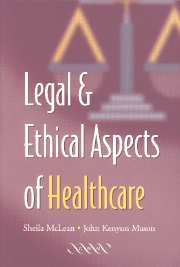Book contents
- Frontmatter
- Contents
- Acknowledgements
- Dedication
- Preface
- A Note on Abbreviations
- 1 About Medicine and the Law
- 2 Resources – Who Decides?
- 3 The Confidential Relationship
- 4 The Therapeutic Partnership
- 5 Refusal of Consent
- 6 Medical Negligence
- 7 Using People for Research
- 8 Assisted Reproduction
- 9 Genetics and Pregnancy
- 10 Termination of Pregnancy
- 11 Genetics, Insurance and Employment
- 12 Is Life Worth Living?
- 13 Disposal of the Body and Body Parts
- 14 Sex, Gender and the Law
- 15 Mental Health and Mental Capacity
- 16 The Law and the Elderly
- Index
4 - The Therapeutic Partnership
Published online by Cambridge University Press: 24 August 2009
- Frontmatter
- Contents
- Acknowledgements
- Dedication
- Preface
- A Note on Abbreviations
- 1 About Medicine and the Law
- 2 Resources – Who Decides?
- 3 The Confidential Relationship
- 4 The Therapeutic Partnership
- 5 Refusal of Consent
- 6 Medical Negligence
- 7 Using People for Research
- 8 Assisted Reproduction
- 9 Genetics and Pregnancy
- 10 Termination of Pregnancy
- 11 Genetics, Insurance and Employment
- 12 Is Life Worth Living?
- 13 Disposal of the Body and Body Parts
- 14 Sex, Gender and the Law
- 15 Mental Health and Mental Capacity
- 16 The Law and the Elderly
- Index
Summary
‘Every human being of adult years and sound mind has a right to determine what shall be done with his own body … .’
This statement, drawn from an American case decided as long ago as 1914, sums up the conditions underlying both ethical and lawful medical intervention. When patients consult their doctors, they expect that decisions as to whether or not they will accept treatment rest with them. Indeed, they may also anticipate that they will be able to choose between different kinds of therapy. This is not to suggest that there is no role for the doctor; he or she is the person with the medical skills, and will, it is expected, act in a way which is of most benefit to their patients, including advising patients as to what he or she thinks is the best treatment. This is no different from consulting, say, a lawyer or an accountant – whenever we consult professional men or women, we invite them to exercise their training and skills. However, the fact that learned advice is sought does not inevitably mean that authority is handed over to the professional to make the final decision. The invitation to act is an invitation to provide advice and recommendations based on acquired skills – but it is for the individual to decide to what use that expertise will be put.
- Type
- Chapter
- Information
- Legal and Ethical Aspects of Healthcare , pp. 45 - 56Publisher: Cambridge University PressPrint publication year: 2003



